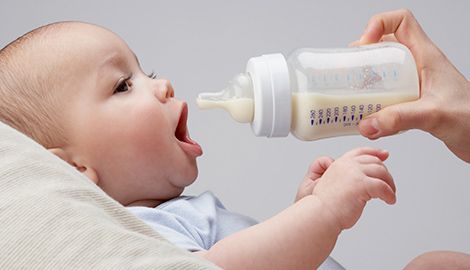The Basics: Feeding & Nutrition – Birth to 6 months

Good nutrition is essential for child development. This is ever more important in the first two years of life, when children’s bodies and minds grow really quickly. Feeding children the liquids and foods appropriate for their age helps them grow healthy and strong. It is recommended that, during the first few months of life, children consume only breast milk and/or infant formula. Breast milk and formula have all the nutrients that children need from birth to six months of age. They do not need other types of milk or fluids, which might harm their developing bodies. For instance, cow’s milk or any drinks or formulas labeled for toddlers can cause serious side effects like intestinal bleeding in children younger than 12 months.
Breast milk and breastfeeding
Breast milk is known as the best source of food for babies and has all the nutrients they need. It also has antibodies from the mother’s body that can help strengthen babies’ immune systems and help them fight illness and infection. Babies can drink breast milk exclusively or in combination with infant formula. (Babies can also drink only infant formula if mothers cannot breastfeed – see details below). It is encouraged that children drink breast milk as long as they can, ideally until 1 year old. There is no specific age when they should stop. Mothers can feed children breast milk directly from their breasts or from a bottle if they extract the milk with their hands or an electric pump. Mothers might need to use a pump and feed from a bottle if they return to school or work before their child stops breastfeeding. Planning ahead can help mothers know where they can pump and safely store breast milk outside the home so it doesn’t spoil. To learn more about properly storing and handling breast milk, check out the Centers for Disease Control and Prevention (CDC) website, below.
Mother’s health
Breastfeeding can have physical and mental health benefits for mothers. For instance, it can help the uterus return to a normal size more quickly after childbirth and lower risks of breast and ovarian cancers, diabetes, and high blood pressure. Breastfeeding also can help mothers bond with their baby. Because breastfeeding can be physically demanding, it is important that mothers stay well-hydrated and well-fed with nutritious foods. It is recommended they drink at least one glass of water every time they breastfeed and eat 450-500 more calories per day than before pregnancy. Diseases and substances that might be harmful to babies can be passed on from mother to baby through breast milk. Mothers who breastfeed might want to limit or avoid substances such as alcohol, and those diagnosed with HIV, Zika, or tuberculosis should talk with a doctor or nurse before breastfeeding.
Seeking help
Some women experience challenges that cause them to stop breastfeeding before they want to. Seek help if you have any questions or run into problems. For instance, you can get help from a lactation consultant (often available at hospitals or at OBGYN offices) for common breastfeeding issues, such as low milk supply and discomfort. You can also become familiar with your rights for breastfeeding in public or pumping milk at work, which can help make it easier to plan these activities outside the home. Talk with your doctor or nurse about any breastfeeding issues or concerns and ask about resources readily available to you. The CDC resources listed below also has helpful information. To find breastfeeding support near you, visit La Leche League’s website, below.
Infant formula
Infant formula is an alternative to breast milk that can be used to complement or replace breast milk as a source of food. Infant formula can be purchased as a liquid or powder and is prepared at home when a child is ready to feed. Talk with your child’s doctor or nurse if you plan to use formula and ask about the type and amount of formula to use. Powder formula can have germs that can cause serious infections for babies if not prepared and stored properly. For instance, unopened formula containers should be stored in cool, dry places and prepared formula should be used within two hours and thrown away if a child does not finish it. See the CDC resources, below, for more information on how to purchase formula and safely prepare and store it. When using bottles to feed your child breast milk or formula, always make sure to clean the bottles and all of their parts (caps, rings, and nipples) before using them again. After taking apart the bottle and rinsing the parts, you can put them in the dishwasher (if the bottle is dishwasher-safe) or you can wash them by hand with soap and hot water. To learn more about how to clean bottles, see the CDC resources below.
Avoid Over-feeding Through “Fullness” Cues
Children often give cues when they are full and do not want to eat any more. For instance, they might close their mouths, push food away, or turn their heads away from a mother’s breast or a bottle. Learning and listening to these cues can help parents promote healthy eating patterns in children from an early age. This can help reduce children’s likelihood of becoming overweight.
Helpful Resources
Breastfeeding (CDC): This website provides a range of helpful information about breastfeeding and breast milk, including how to properly store and manage breast milk, how to clean breast pumps, and where mothers can find breastfeeding support. Find Local Help (La Leche League): This website provides a search engine that mothers can use to find breastfeeding support near where they live. Infant Formula (CDC): This website offers information for how to feed infants formula, as well as guidance for choosing, preparing, and storing formula. The information in this article is intended to be used for educational purposes only. It is not medical advice. Always consult a doctor or other healthcare professional when making decisions about your health.
